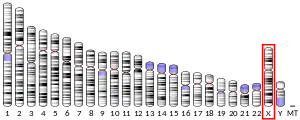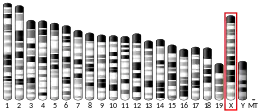H2AFB1
Histone H2A-Bbd type 1 also known as H2A Barr body-deficient is a histone protein variant that in humans is encoded by the H2AFB1 gene (H2A histone family, member B1).[5]
| H2AB1 | |||||||||||||||||||||||||||||||||||||||||||||||||||
|---|---|---|---|---|---|---|---|---|---|---|---|---|---|---|---|---|---|---|---|---|---|---|---|---|---|---|---|---|---|---|---|---|---|---|---|---|---|---|---|---|---|---|---|---|---|---|---|---|---|---|---|
| Identifiers | |||||||||||||||||||||||||||||||||||||||||||||||||||
| Aliases | H2AB1, H2A.Bbd, H2A histone family member B1, H2A.B, H2A.B variant histone 1, H2AFB1, H2A.B.2 | ||||||||||||||||||||||||||||||||||||||||||||||||||
| External IDs | MGI: 3644980 HomoloGene: 129517 GeneCards: H2AB1 | ||||||||||||||||||||||||||||||||||||||||||||||||||
| |||||||||||||||||||||||||||||||||||||||||||||||||||
| |||||||||||||||||||||||||||||||||||||||||||||||||||
| |||||||||||||||||||||||||||||||||||||||||||||||||||
| |||||||||||||||||||||||||||||||||||||||||||||||||||
| |||||||||||||||||||||||||||||||||||||||||||||||||||
| Wikidata | |||||||||||||||||||||||||||||||||||||||||||||||||||
| |||||||||||||||||||||||||||||||||||||||||||||||||||
Function
Histones are basic nuclear proteins that are responsible for the nucleosome structure of the chromosomal fiber in eukaryotes. Nucleosomes consist of approximately 146 bp of DNA wrapped around a histone octamer composed of pairs of each of the four core histones (H2A, H2B, H3, and H4). The chromatin fiber is further compacted through the interaction of a linker histone, H1, with the DNA between the nucleosomes to form higher order chromatin structures. This gene encodes a member of the histone H2A family. This gene is part of a region that is repeated three times on chromosome X, once in intron 22 of the F8 gene and twice closer to the Xq telomere. This record represents the most centromeric copy which is in intron 22 of the F8 gene.[5]
References
- GRCh38: Ensembl release 89: ENSG00000274183 - Ensembl, May 2017
- GRCm38: Ensembl release 89: ENSMUSG00000082482 - Ensembl, May 2017
- "Human PubMed Reference:". National Center for Biotechnology Information, U.S. National Library of Medicine.
- "Mouse PubMed Reference:". National Center for Biotechnology Information, U.S. National Library of Medicine.
- "Entrez Gene: H2A histone family".
Further reading
- Strausberg RL, Feingold EA, Grouse LH, et al. (2002). "Generation and initial analysis of more than 15,000 full-length human and mouse cDNA sequences". Proc. Natl. Acad. Sci. U.S.A. 99 (26): 16899–903. Bibcode:2002PNAS...9916899M. doi:10.1073/pnas.242603899. PMC 139241. PMID 12477932.
- Chadwick BP, Willard HF (2001). "A Novel Chromatin Protein, Distantly Related to Histone H2a, Is Largely Excluded from the Inactive X Chromosome". J. Cell Biol. 152 (2): 375–84. doi:10.1083/jcb.152.2.375. PMC 2199617. PMID 11266453.
- Bao Y, Konesky K, Park YJ, et al. (2004). "Nucleosomes containing the histone variant H2A.Bbd organize only 118 base pairs of DNA". EMBO J. 23 (16): 3314–24. doi:10.1038/sj.emboj.7600316. PMC 514500. PMID 15257289.
- Naylor JA, Buck D, Green P, et al. (1995). "Investigation of the factor VIII intron 22 repeated region (int22h) and the associated inversion junctions". Hum. Mol. Genet. 4 (7): 1217–24. doi:10.1093/hmg/4.7.1217. PMID 8528212.
- Ioudinkova ES, Barat A, Pichugin A, Markova E, Sklyar I, Pirozhkova I, Robin C, Lipinski M, Ogryzko V, Vassetzky YS, Razin SV (2012). "Distinct distribution of ectopically expressed histone variants H2A.Bbd and MacroH2A in open and closed chromatin domains". PLOS ONE. 7 (10): e47157. Bibcode:2012PLoSO...747157I. doi:10.1371/journal.pone.0047157. PMC 3484066. PMID 23118866.
- Tolstorukov MY, Goldman JA, Gilbert C, Ogryzko V, Kingston RE, Park PJ (August 2012). "Histone variant H2A.Bbd is associated with active transcription and mRNA processing in human cells". Mol. Cell. 47 (4): 596–607. doi:10.1016/j.molcel.2012.06.011. PMC 3708478. PMID 22795134.
This article incorporates text from the United States National Library of Medicine, which is in the public domain.



